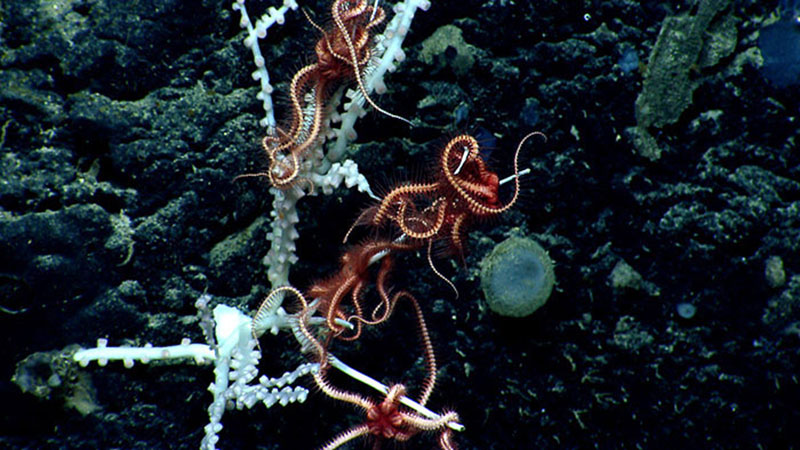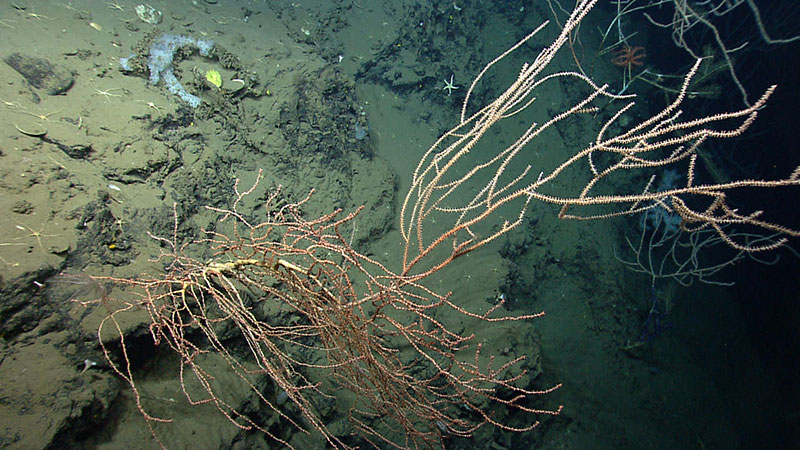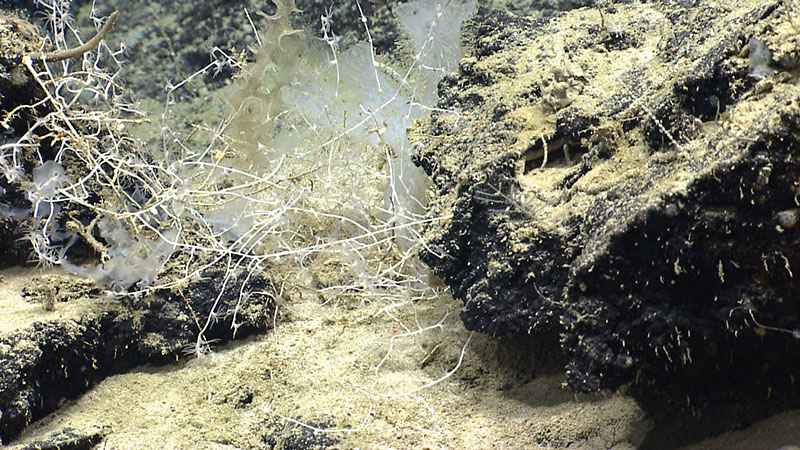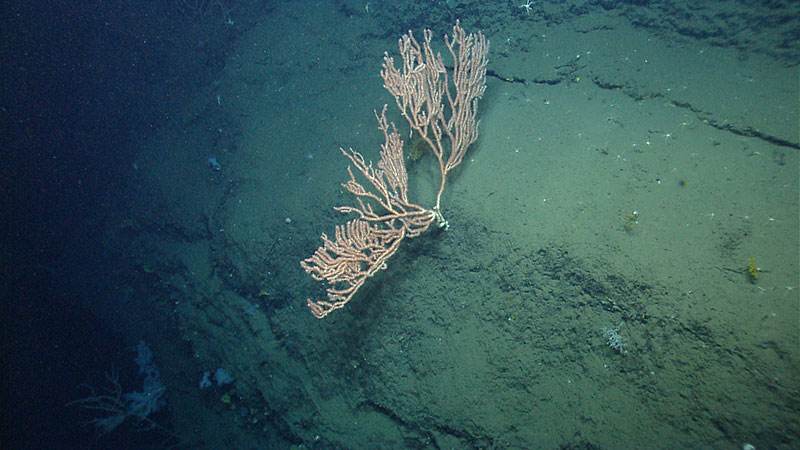
by Scott C. France, Ph.D., University of Louisiana at Lafayette
August 7, 2013

Close-up of a "young" bamboo coral colony. You can see the white axial skeleton very clearly through the transparent tissue and one dark node near the base. The polyps have contracted and withdrawn their tentacles. The two large red polyps in the background are the octocoral Anthomastus. Image courtesy of the NOAA Office of Ocean Exploration and Research, Northeast U.S. Canyons Expedition 2013. Download larger version (jpg, 1.1 MB).
If you have been following along on the live dives of the NOAA Ship Okeanos Explorer Northeast U.S. Canyons Expedition, you have likely heard several times the cry of “Bamboo coral!” With a little practice, most bamboo corals can be fairly quickly recognized in deep-sea video. However, such an identification only begins to scratch at the surface of the actual biodiversity we are seeing. So what is a bamboo coral [and why are we so interested in them]?
The common name “bamboo coral” refers to a more formal grouping of species that comprise the Family Isididae. All the species of this family of octocorals (corals whose polyps have eight tentacles) share the characteristic of having an internal skeleton that has short nodes – made of protein that is dark black or brown in color - alternating with longer internodes – made of calcium carbonate that is white in color. The effect of these alternating black nodes and white internodes reminded early biologists of bamboo, hence the common name.

Keratoisis-like bamboo coral with several brittle stars (Ophiuroids) on the branches. The branch on lower right has no tissue on it but tissue and short squat polyps can be seen on the other branches. At least one dark node can been seen through tissue on the branch on lower left. Image courtesy of the NOAA Office of Ocean Exploration and Research, Northeast U.S. Canyons Expedition 2013. Download image (jpg, 111 KB).
We can usually see the skeleton in the living colonies because the living tissue covering it is so thin, thus making them “relatively” easy to identify in the video as bamboo corals. But there are actually four subfamilies of bamboo coral – subgroups of species that share characteristics. All of the bamboo corals we are seeing belong to the subfamily Keratoisidinae, whose species are very common in the deep sea and are distributed around the world in all oceans from as shallow as 200 meters to deeper than 4,000 meters.
Although we know Keratoisidinae species have been found in all oceans, we don’t know how many or which species are found in the canyons cutting through our northeast continental slope, nor do we know much about their abundance or the kind of micro-habitat they are living in or the deep-sea species that may associate with them (these questions can be asked about most of the deep-sea corals in these canyons). These are some of the questions on our mind as we explore using the outstanding imaging capabilities of the remotely operated vehicle, Deep Discoverer.

An unidentified bamboo coral projecting off the side of a wall. The colony is quite large and likely decades old. The older living tissue closer to the base has a reddish hue, while the younger branches at the tips have whitish tissue. Image courtesy of the NOAA Office of Ocean Exploration and Research, Northeast U.S. Canyons Expedition 2013. Download larger version (jpg, 1.6 MB).

"Bramble" bamboo coral. These colonies (at least when "younger") have very thin branches and grow in these tangled thickets. You can see the polyps arising from several branches; they are very widely spaced along each branch. There appears to be a sponge intertwined with the bramble; the parts of the sponge that are brownish are dead, and the living parts white. Image courtesy of the NOAA Office of Ocean Exploration and Research, Northeast U.S. Canyons Expedition 2013. Download larger version (jpg, 1.6 MB).
Understanding more about how common or rare these species are and what other animals use the corals (as habitat to perch on or deposit eggs on, as food, or as protection from their own predators), will help guide decisions on conservation needs in these deepwater communities.
We have seen at least seven different species of Keratoisidinae (collections would have to be made to examine microscopic details and DNA to determine exactly how many species and their identities), some in great abundance. As someone who has studied bamboo corals for many years and seen them in many deep-sea habitats, I was astounded by the high densities of colonies we saw in Block Canyon at >1,300 meters depth. We have seen some marvelously large fan-shaped colonies about 2 meters (6 feet) tall and 3 meters (10 feet) wide, abundant “bramble” colonies that appear as tangled clumps of intertwined branches, and even spiraling whip-like colonies reaching over 8 feet from the bottom. We have seen sea urchins and seastars feeding on bamboo corals and amphipods, shrimp, crinoids (feather stars), anemones, barnacles, worms and other invertebrates perched on their branches.
Clearly bamboo corals play a major role in the deep-sea communities of these canyons and seamount.

The marvelous giant bamboo fan, Jasonisis, from Nygren Canyon. Image courtesy of the NOAA Office of Ocean Exploration and Research, Northeast U.S. Canyons Expedition 2013. Download larger version (jpg, 1.6 MB).